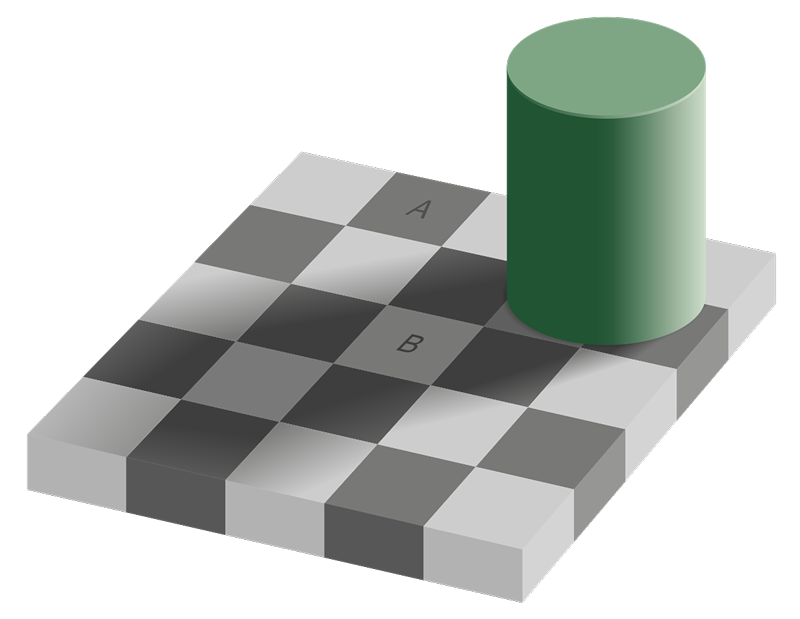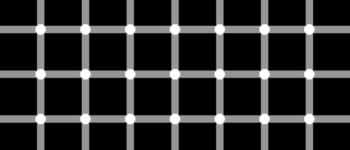Adelson's board, a shocking optical illusion

- 846
- 167
- Hugh Greenholt
The Adelson board refers to an optical illusion in which a chess board is presented, in which An area seems to be a darker color than another area, whose color is the same. That is, both are the same color.
This Optical Illusion of Adelson's board has gone viral. There have been thousands who have tried on the Internet to succeed which box of the board is darker or clearer, but, the truth is that there is nothing to discuss, since the two have the same hue.
What is this about? As in many other incredible optical illusions, sight and our brain are always present.
Content
Toggle- The Optical Illusion of the Adelson Board
- The wonderful effect of shadows
- Our visual system and our brain intervene
- Bibliography
The Optical Illusion of the Adelson Board
The optical illusion of the Adelson Board, also known as "The illusion of the shadow of the chess board", was presented in 1995 By the American professor, specialist in vision sciences, Edward H. Adelson, assigned to the Massachusetts Technology Institute (MIT).
At that time, the fury did not wait before that chess board, then baptized as the "Adelson Board", in which there are a series of boxes whose colors are different, but, two of them stand out.
On the board, there is a box, labeled with the letter to which it stands out more than the rest, thanks to the gray tone that it possesses. On the other hand, there is another box, labeled with the letter B, in which its tone seems white, but it is due to the shadow that projects a cylinder that is nearby.
Although the box with the A label seems darker than the box with the letter B, in reality, they are the same color. On this board, the cylinder and the shadow that this projects, seem to be decisive to obtain an explanation.
This optical illusion takes place because our brain not only captures the gray tone, from the visual information obtained at the moment, but also thanks to its ability to establish comparisons with the other boxes it has in the environment.
Then, box A, which is surrounded by lighter boxes, we take it as darker, due to the contrast that occurs, while with box B the opposite happens.
In other words, The two boxes have the same color, but, the shadow of the cylinder causes the clear boxes to look darker And, it makes them seem as dark as the rest.
Also, there is another equally amazing detail, and that is that the shadow does not have a definite edge, but that this is diffuse, so our vision ignores the change of tones.
The wonderful effect of shadows
The optical illusion of the Adelson board makes us understand how attractive the role of shadows and how it can act in our visual system, as well as to inspire many artists even.
The shadow is responsible for making an object be seen differently.
In this case, The green cylinder projects a shadow on several boxes on the board and this influences our vision. Indeed, the area marked with the letter B has that grayish tone is due to the shadow and that is why it looks so different from the box.
On the effects that the shadow can produce in our visual field, the chemical engineer to. Tamir, from the University of Negev, in Israel, and engineer Francisco Ruiz, from the University of Alicante, make a quite interesting reflection about it.
For these authors, in their study entitled Science and Art, Light and Shadow, many of the concepts of light and shadow that are explained at the scientific level, can be illustrated in works of art.
For them, light is a radiant energy type that produces a stimulus in vision organs.
Instead, The shadow is a dark shape, which occurs on the ground or on a wall, and that is caused by a person or object that covers the light.
To exemplify them, these authors even resort to Chapter 1 of the Book of Genres, in which it is mentioned that God created the light, which he called day, and the dark, which he called night.
However, for them, the shadow is not mentioned in this book because, according to its definition, It is necessary that an object be present to block the light, And this was not created the first day, but after. How amazing, right?
This only shows us a small significant part of everything that hides the shocking world of optical illusions.
 Optical illusion of the grid
Optical illusion of the grid Our visual system and our brain intervene
Before the illusion of the Angeson board we can ask ourselves why we see the boxes of different color, but we already know the answer.
Everything is due to our visual system and to the difficulty that arises in this when verifying the gray tones on the board.
When the amount of light on the board is measured, our visual system is unable to capture in detail the different shades, due to the shadow that projects the green cylinder.
Thus, the white surface under the shadow comes to be perceived with less light than the black surface, when exposed to light without any obstacle.
This explains why our visual system always needs to define or place labels to each object we see, then, Our brain tries to identify where the lights and shadows come from And how to establish a balance.
In the case of the Board of Adelson, our brain makes an analysis of all the pieces and how those surrounding the marked with the letter A are darker, then the brain interprets that box B is clearer, even when they have the same tone.
Definitely, optical illusions have much to teach us about the functioning of our visual system and on the brain. That is why they are not only a simple entertainment, but have given rise to different debates in the scientific world.
Ames's room
Bibliography
- Arias, r. M. (2016). Perplexed reason: a mathematical-philosophical experience. SMPC newsletter, 17, 33-38.
- Eagleman, d. (2017). Brain(Vol. 510). Anagram.
- Iagar, r. (2017). Mathematics and chess. The books of the cataract.
- Tamir, a., & Ruiz Beviá, F. (2008). Art and Science: Light and Shadow.

